What can be a faucet for a washbasin
It is not difficult to pick up a faucet for a country washbasin, but for this you need to specifically understand what capacity you will have, where water will be drawn - this includes not only the volume, but also the material from which the washstand is made.
Also, the choice of a crane may differ by material, but such a difference can also be classified by the type of valves (crane box or ball). Despite such different parameters, it is very easy to understand this, if you understand the meaning of one or another factor, and we'll talk about it below, and also let us give you the video in this article.

Difference in cranes
According to the material

- As a rule, brass taps with different shut-off valves are installed on one water with a metal container, since it is quite convenient to fix them to the tank wall. When choosing such a mechanism, it is important that you do not slip silumin (aluminum alloy with silicon) - this material is too fragile and the mechanism quickly fails. The fact is that silumin and brass can be white, but brass is always much weightier.
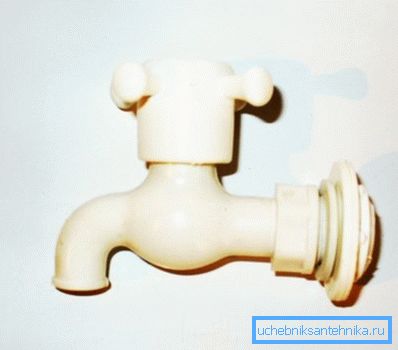
- At present, plastic models are quite popular, especially since the instruction allows them to be installed on both plastic and metal containers, which makes them more widely used.. It is noteworthy that this category also includes polypropylene through-ports, which can be soldered to the spout, and connected to the washbasin using transition fittings.
Valves
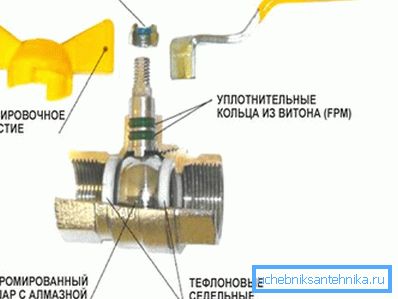
- Valves of this type is a ball with a hole in the middle, which rotates around its axis in the body and is driven by a rod and a handle (flag) attached to it. If the hole in the direction of flow is open completely, then the patency is considered complete at this moment, but when the lever is turned, the rod turns the ball and the hole decreases until it turns to the body walls - in this position the flow is completely blocked.
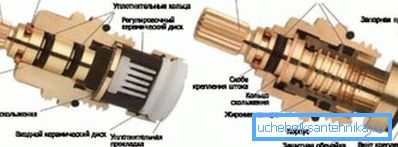
- As a locking mechanism, a semi-rotary crane can have not only a ball, but also a so-called ceramic crane-bush — the so-called one, because only a pair of plates with holes are made of ceramics that regulate the carrying capacity of the mechanism. On these plates, the holes are offset from the center and one of them is fixed (lower), and the other is driven by a rod, on which a lever or thumb is put on. The degree of pressure or its complete overlap depends on how well these holes coincide.
- More familiar to all, the old crankcase with a worm gear and a rubber valve at the end of the stem, but they are still produced, and they are in demand. The essence of the operation is as follows - the rod, rotating along the threads of the worm gear, lowers and raises the rubber valve, thereby regulating the power of the water flow.
Note. It should be noted that the faucet for the bathroom and the washbasin can also have a similar shut-off valve, but such mechanisms are not used for the street. If you make or buy a washstand with heating, then you will be able to put a double-action faucet to the sinks.
Installation

If we decided to do our own washbasin with a tap for the dacha, then first of all, we will have to find a suitable container for this, the volume of which would correspond to our needs, and the material can be either metal or plastic.
But to install the crane, in any case, we will need a hole, which is much easier to drill in plastic containers, and for this we need an electric drill or screwdriver, as well as a core mill (steel or with a diamond-coated) across the nozzle diameter.
Tip: you can use for this purpose a metal canister or some self-welded cube, but the cutter is indispensable. As a rule, the metering tap for a washbasin has a half-inch fitting or an internal pipe thread of the same diameter, then you still have to install the fitting half an inch, but it is difficult to find a drill with that diameter, and if you do, you will need a special cartridge for the clamp.
But you can go the other way - use for this a drill with a diameter of 2-3 mm (the thinner, the neater the hole will turn out). You will need to draw a hole with a marker at the place where you will be doing it, and pass it along the perimeter with a thin drill bit - the smaller the step, the better, and the partitions can be cut with a file.
After you remove the center, pass the edges with a semicircular file so that there are no pieces of partitions and burrs left.
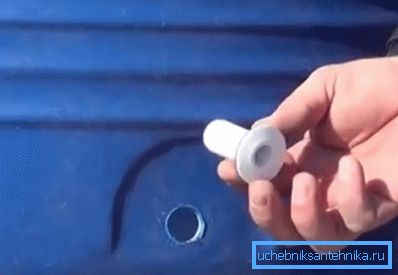
Now we have two ways - either we screw the faucet itself into the hole, if it is with an external thread, or if there is an internal thread, we twist the fitting into the hole, and both metal and plastic parts will be suitable for this.
In that case, if the hole was made in plastic, as in the top photo, then you hardly need gaskets - the flange from the inside and the nut from the outside will tightly close the hole if it is made to fit.
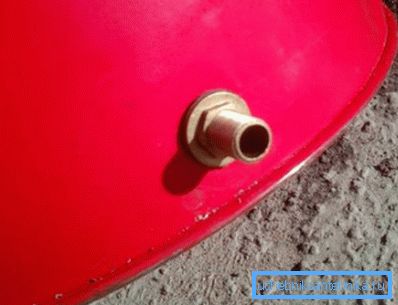
But with metal, most likely, this will not work, especially if the hole was made with a small drill, but this is not a problem at all - there are washers and gaskets for this. Just put big metal washers on both sides so that they block the hole well and put rubber gaskets under them. When you tighten it with a nut - there will be no leak.
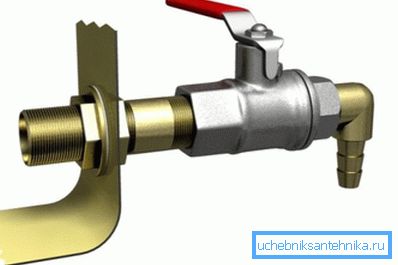
Council Imagine that you want to make a galvanized washbasin 20l with a faucet and a lid, but at the same time you can not find the right fitting. But this is not a problem - you can always replace it with a run if you screw the nut on the inside.
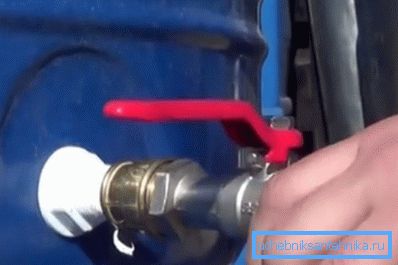
Now we just have to turn the faucet on the joint or choke (if we chose the model with internal thread) and here we already need the fum-tape and sanitary paste UNIPAK. You wind up six to ten turns of fum tape on the thread of the sgon (it all depends on its thickness) and spread it on top with paste so that the ointment is applied to the entire surface of the threaded connection.
Then you start to wind the crane, but make sure that the tape does not slip - if this happens, then remove it and rewind another piece (its price is not so great), just make sure that the winding has the appearance of a cone.
If the threaded connection of pipes is made using fum-tapes and sanitary paste UNIPAK, then there should not be a leak - such auxiliary means are specially used so that after twisting it is possible to turn the part back and not to break the blockage.
However, the check is always needed, so pour water into the tank, try the faucet (open and close it several times), and then check the joint with toilet paper. Even with the slightest leakage of water on paper, a wet trace will remain (if this happens, the compound will need to be repacked).
Conclusion
In conclusion, we can say that any container - a barrel, a saucepan or a canister - a washbasin with a tap will always be needed in a country house, especially if you do not have an automatic water supply. And you will be able to install such a structure, both indoors and outdoors.